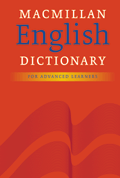Introduction
What is a phrasal verb?
Phrasal verb, multi-word verb, two-part verb?
Definition
 From the Macmillan English Dictionary - Language Awareness section**
From the Macmillan English Dictionary - Language Awareness section**
A Phrasal Verb is a verb formed from two (sometimes three) parts; a verb and an adverb or preposition. Most are formed from a small number of common verbs (such as get, go, come, put and set) and a small number of adverbs and prepositions (such as away, out, off, up and in)
Phrasal verbs sometimes have meanings that can easily be guessed (such as sit down or look for). But in most cases their meanings are quite different from the meaning of the verb they are formed from: for example hold up can mean 'to cause a delay' or 'to try to rob someone' and has no obvious connection with the idea of 'holding' something.
What is different about phrasal verbs?
In one sense, you can say that phrasal verbs are just more words and should be treated as such. However, there are problems also with the grammar. Different phrasal verbs have different grammar. Here is the grammar of phrasal verbs:
Grammar - How do phrasal verbs function grammatically?
There are five types of phrasal verb. These are:
- intransitive (with no object):
You're driving too fast - you ought to slow down. - transitive verbs whose object can come in two positions - after the verb or after the particle:
I think I'll put my jacket on OR I think I'll put on my jacket.
If the object is a pronoun, however, it must come between the verb and the particle: I think I'll put it on (NOT I think I'll put on it).
transitive verbs whose object must come between the verb and the particle:
Its high-quality designs sets the company apart from its rivals- transitive verbs whose object must come after the particle:
The baby takes after his mother - Why do you put up with the way he treats you. - verbs with two objects - one after the verb, the other after the particle:
They put their success down to good planning.
From the Macmillan English Dictionary - Language Awareness section**
Formality
Phrasal verbs are more informal, and are found in informal texts and in spoken language. Many phrasal verbs have a Latinate equivalent. When students opt for this equivalent, they sound more formal. Conversely, a student who uses an informal phrasal verb in a formal situation (like a business letter) can sound out of place or wrong.
How NOT to teach phrasal verbs
Often learners will tell you with a shake of their head that they really need to “do some phrasal verbs”. This area of English is often seen as extremely daunting, difficult and tedious. Why? Perhaps it’s because the teaching of phrasal verbs has been daunting and difficult for the TEACHER, and therefore tedious for the LEARNER.
Try to avoid teaching phrasal verbs in the following ways:
- by presenting huge lists (in fact, lists of words the cover a page are unimaginative and daunting for any item of vocabulary, imagine having to learn all the animals by looking at a page with their names on it)
- by focussing always and exclusively on the verb (e.g. phrasal verbs with GET). Often this results in a list (admittedly shorter) of verbs that are unrelated and can be confused.
How to approach, and teach phrasal verbs
First of all, stop communicating to students that phrasal verbs are impossible. This can quickly become a self-fulfilling prophecy. The message should be that phrasal verbs are just more words, that they are not that difficult to learn, and that students have already (by an elementary stage) acquired quite a few without realising it (see the first lesson in this series of phrasal verbs for examples of phrasal verbs that students quickly pick up in the classroom).
This still leaves problems for you, as the teacher. How do you teach phrasal verbs in a fun, motivating way when so much material out there is dry and difficult to work with? That’s what this section is all about. We hope it helps!
Monthly activities, lesson plans and exercises
Introducing Phrasal Verbs. Who says phrasal verbs are only for intermediate level students and up? This lesson is for elementary or false beginners to introduce some common phrasal verbs. It can be used with higher levels who are suffering from “phrasal verb anxiety” and need to be reminded that it is not that difficult!
Introducing phrasal verbs to elementary students
Introducing phrasal verbs to elementary students (lesson plan, worksheets, tips and interactive exercises)
** Macmillan English Dictionary - Language Awareness Section
The language awareness section of MED includes up-to-date information on topics that are relevant to anyone who has any interest in the way the English language is being used at the beginning of the 21st century. They are intended to give you a deeper understanding of such areas as Spoken Discourse, Metaphor, and Pragmatics. They also include articles on Numbers, Phrasal Verbs, Academic Writing, Computer Words, Sensitivity: avoiding offence, British and American English, Business English and Word formation.
Find out more: www.macmillandictionary.com
The materials in this section are prepared by Lindsay Clandfield a former winner of the Lesson Share competition.




No comments yet